Suitability Analysis of the CME CF Litecoin-Dollar Reference Rate as a Basis for Regulated Financial Products
This paper seeks to understand whether these qualities are achieved by CF Benchmarks' CME CF Litecoin-Dollar Reference Rate - London Variant (LTCUSD_RR).
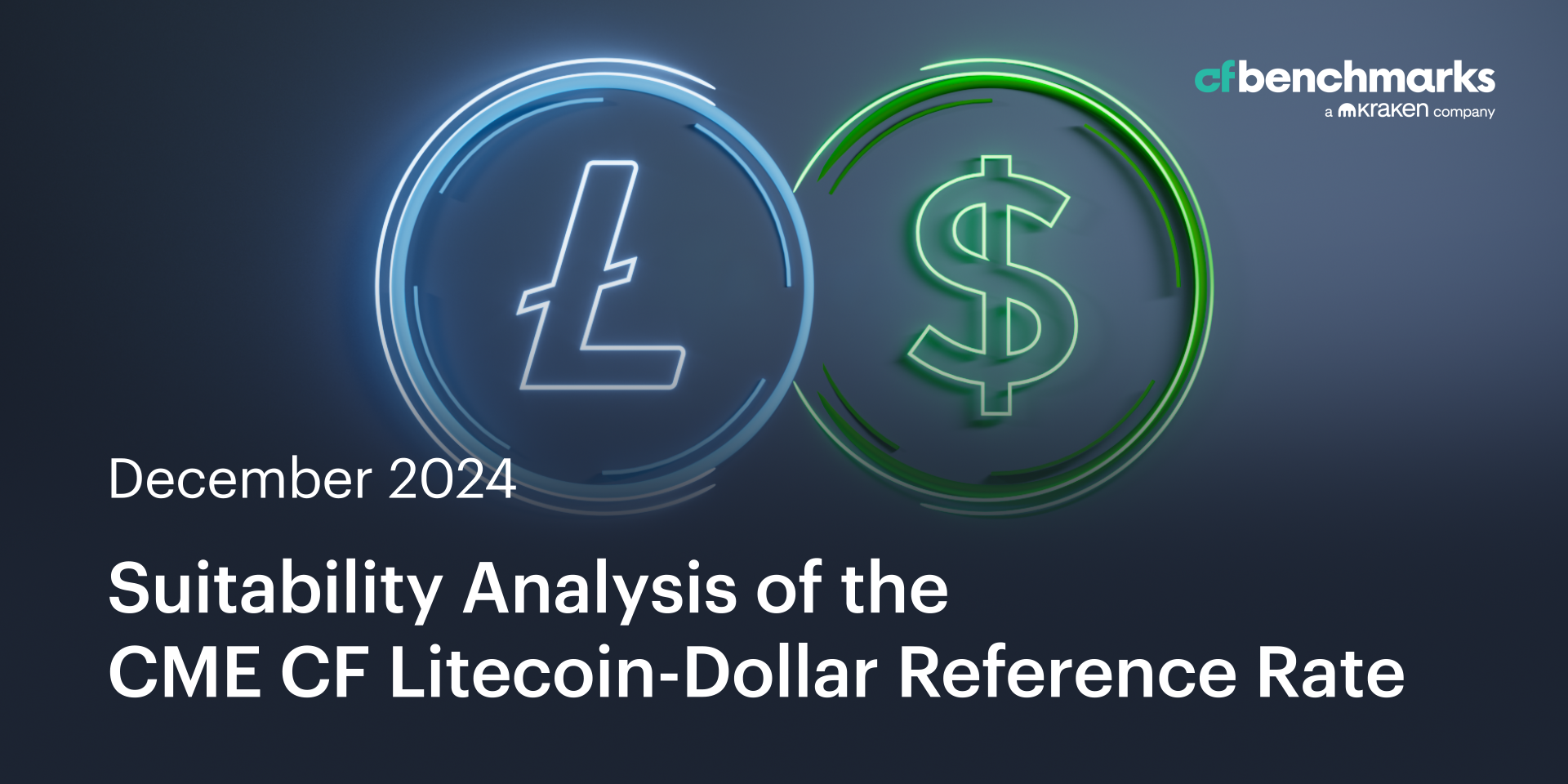
Benchmarking the Price of Litecoin
The history and evolution of Litecoin
Litecoin (LTC), introduced in October 2011 by former Google engineer Charlie Lee, emerged as one of the first alternatives to Bitcoin. Designed to address Bitcoin’s limitations in speed and efficiency, Litecoin reduced the average block generation time to 2.5 minutes compared to Bitcoin’s 10 and employed a distinct proof-of-work algorithm initially aimed at making mining more accessible to everyday hardware.
Motivated by a desire to preserve Bitcoin’s core principles of decentralization and security while enhancing usability and cost-effectiveness, Litecoin quickly established itself as a practical digital currency. Often referred to as “digital silver” in contrast to Bitcoin’s “digital gold,” Litecoin is recognized as a cost-effective alternative well-suited for transactions.
Litecoin’s adaptability is evident in its history of implementing innovative upgrades. In 2017, it adopted Segregated Witness (SegWit) ahead of Bitcoin, demonstrating its ability to integrate advancements swiftly. More recently, the 2022 introduction of the Mimblewimble Extension Block (MWEB) added optional privacy and scalability features, further enhancing its utility. This consistent evolution solidifies Litecoin’s reputation as a reliable and enduring player in the cryptocurrency ecosystem.
A top-tier Cryptocurrency
At the time of writing in late 2024, Litecoin consistently ranks among the top 25 cryptocurrencies by market capitalization, with a valuation of around $8 billion, according to CoinMarketCap.
Active address figures highlight Litecoin’s sustained relevance. Data from Swyftx in December 2024 estimated that Litecoin has over 300,000 daily active addresses. While this number is lower than those of networks supporting smart contracts, Litecoin’s usage metrics demonstrate its continued footprint in the broader crypto economy.
Although Litecoin is not closely associated with decentralized finance (DeFi) ecosystems like Ethereum or Solana, it is frequently recognized for its reliability and robust network security. This reputation is underpinned by a large and active community of miners and node operators. In 2024, Litecoin mining has experienced significant growth, with its hash rate increasing by roughly 110%, further reinforcing its status as a secure digital currency.
Institutional Participation
Litecoin’s enduring presence in the cryptocurrency landscape has attracted interest from institutional players. In 2018, Grayscale Investments introduced the Litecoin Trust (LTCN), allowing accredited investors in the US to gain exposure to LTC through a regulated security. The first Litecoin exchange-traded products (ETPs) were launched in April 2021 by CoinShares and the ETC Group, providing additional regulated avenues for investors to gain exposure to Litecoin in Europe.
In the exchange traded derivatives space there are regulated cash settled Litecoin futures contracts listed for trading on recognised Trading Venues since 2018 in the UK (Kraken MTF, a Multi Lateral Trading Facility regulated by the UK FCA) and since April 2024 in the US (Coinbase Derivatives, a CFTC regulated DCM).
Benchmarking Litecoin
As the number of regulated cryptocurrency investment products continues to grow, the demand for independent, transparent price sources likewise rises. Litecoin, as a legacy cryptoasset, is frequently included in broader market indices and composite benchmarks, reflecting its liquidity, longevity, and continued market relevance.
For a pricing source to be utilised by regulated institutions as the benchmark for regulated products, it must fulfil what CF Benchmarks has referred to as the 'Three Rs', three essential prerequisites that determine its suitability for this role. These pillars also determine whether or not a price source meets the standards required of pricing benchmarks as defined by the Benchmarks Regulation (BMR) framework: the benchmark must be representative of the underlying market, resistant to manipulation, and replicable by market participants.
The CME CF Litecoin-Dollar Reference Rate (LTCUSD_RR)
The CME CF Litecoin-Dollar Reference Rate (LTCUSD_RR) is a once-a-day benchmark index price for Litecoin denominated in US Dollars. Input data is obtained from major cryptocurrency exchanges that conform to the CME CF Constituent Exchange Criteria. Calculated every day since its launch on 25th April 2022, the LTCUSD_RR is a regulated Benchmark under the UK Benchmarks Regulation (BMR) regime.
Calculation Methodology
The LTCUSD_RR calculation methodology aggregates transactions of Litecoin in U.S. dollars that are only conducted on the most liquid markets for which data is publicly available and operated by exchanges that meet the CME CF Constituent Exchange Criteria.
The list of Constituent Exchanges and information about changes to its composition are available at the following URL:
https://docs.cfbenchmarks.com/CME%20CF%20Constituent%20Exchanges%20Criteria.pdf
The full methodology is also available here:
https://docs.cfbenchmarks.com/CME%20CF%20Reference%20Rates%20Methodology.pdf
The methodology can be summarised thus:
- Transactions conducted on Constituent Exchanges are observed during a one-hour window from 15.00 to 16.00 London Time
- The one-hour window is divided into 12 partitions of equal length (five minutes each)
- For each partition, a volume-weighted median (VWM) is calculated
- The index value is expressed as the arithmetic mean of the 12 VWMs calculated in the previous step
Timing of the Benchmark - Suitability of 16.00 London Time as calculation time
The graph in Figure 1 illustrates the rationale of calculating the CME CF Litecoin-Dollar Reference Rate (LTCUSD_RR) at 16.00 London Time. For the data set illustrated, Litecoin-U.S. dollar transaction volumes on Constituent Exchanges were measured over an observation period of December 1st, 2022, to December 22nd, 2024.
Figure 1
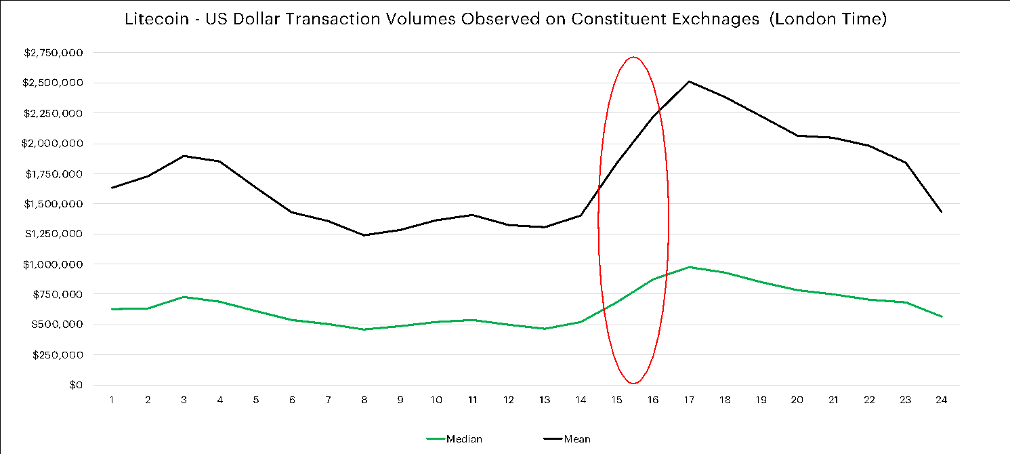
Unlike most traditional assets, Litecoin can be traded at any time of the day. But the trading data shown in the above graph clearly indicates that Litecoin market participation volume adheres quite closely to times when traditional markets tend to experience their own high trading volumes.
One of the most liquid times of the day for Constituent Exchange volumes, together with the typical 4pm traditional market closing time of several large European cities, points to an optimal time of 15.00 to 16.00 London Time to measure transactions for a daily benchmark price of Litecoin.
Benchmark validity and volume sufficiency
A valid and robust benchmark needs to be calculated from input data of sufficient volume so that it is representative of the market it seeks to measure. From a practical perspective, volume sufficiency is also key in order for the benchmark to be replicated by institutional market participants and product providers that need to warehouse price risk. To understand how the LTCUSD_RR measures up, data summarising an average number of Litecoin and an average US Dollar value per day observed each month during the observation window are presented in Figure 2.
Figure 2
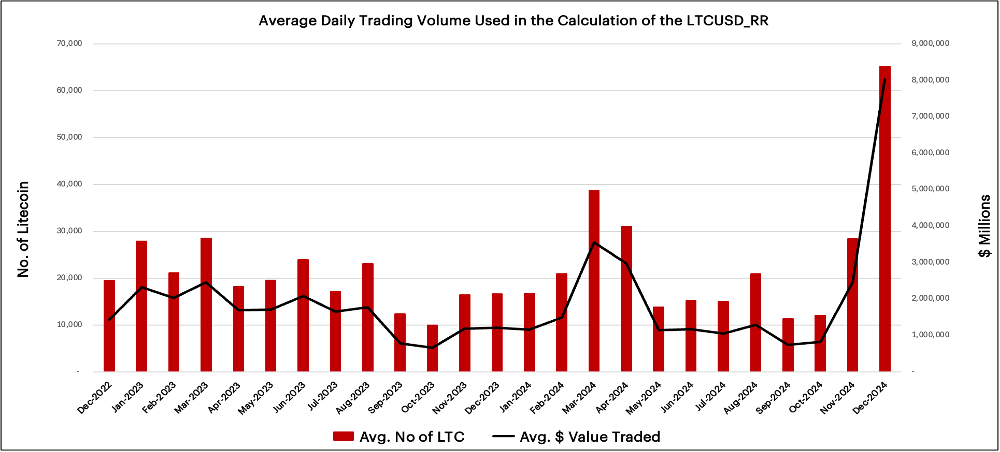
As can be seen between December 1st, 2022, to December 22nd, 2024, on average, 21,780 Litecoin, or $2.2M (at contemporaneous USD prices) were traded across an average of 4,094 transactions during each daily observation window between 15:00 and 16:00 London Time on the LTC-USD markets of CME CF Constituent Exchanges used as input data to the LTCUSD_RR. Whilst trading activity exhibits volatility, this volatility is not substantially different from that shown in traditional asset markets. In conclusion, the volume observed and the reliability of that volume are clearly evident to be sufficient for the calculation of a robust and reliable benchmark.
Resistance to Manipulation – Benchmark Integrity
This section will address the question of whether the CME CF Litecoin-Dollar Reference Rate is possessed of integrity in the specific sense applied by securities regulation. The practical imperative is that a benchmark requires integrity because it will be used for a wide range of activities such as asset valuation, settlement of financial risk, risk management, NAV calculation, unit creation and unit redemption. Specifically, the benchmark must both be shown to be free of manipulation and furthermore, it must be administered and calculated in a manner that deters and impedes manipulation.
Deterring and Impeding Manipulation
The methodological design underlying the CME CF Litecoin-Dollar Reference Rate and its system of administration incorporate measures that promote integrity as outlined in the sub-sections below.
Impeding Manipulation by Input Data selection
CF Benchmarks exclusively sources input data from Constituent Exchanges that meet published criteria as set out in its Constituent Exchanges Criteria. The criteria are available at this link: https://docs.cfbenchmarks.com/CME%20CF%20Constituent%20Exchanges%20Criteria.pdf. Particular attention is drawn to the following statement from the Constituent Exchanges Criteria document (part 2 of Section 3, page 5: ‘Eligibility Criteria’):
“The venue has policies to ensure fair and transparent market conditions at all times and has processes in place to identify and impede illegal, unfair or manipulative trading practices.”
CF Benchmarks ascertains the presence of fair and transparent market conditions and processes to identify and impede illegal, unfair or manipulative practices by conducting a thorough review of any exchange under consideration for inclusion as a Constituent Exchange. The arrangements of all Constituent Exchanges are reviewed annually to ensure that they continue to meet all criteria specified within “Constituent Exchange Criteria”. This due diligence is documented, and the information is distributed to CF Benchmarks’ oversight organs to consider. The deliberations of oversight organs are conducted during regular meetings, minutes of such meetings are publicly available, being published by the Administrator on its website.
Manipulation resistance by design
Resistance to manipulation is a priority aim of the design methodology underlying the CME CF Litecoin-Dollar Reference Rate. The methodology takes an observation period and divides it into equal partitions of time. The volume-weighted median of all transactions within each partition is then calculated. The benchmark index value is determined from the arithmetic mean of the volume-weighted medians, equally weighted. The benefits of this process with respect to achieving manipulation resistance are outlined below.
- Use of partitions
Individual trades of large size have limited effect on the Index level as they only influence the level of the volume-weighted median for that specific partition.
A cluster of trades in a short period of time will also only influence the volume-weighted median of the partition or partitions they were conducted in.
- Use of volume-weighted medians
Use of volume-weighted medians as opposed to volume-weighted means ensures that transactions conducted at outlying prices do not have an undue effect on the value of a specific partition.
- Equal weighting of partitions
By not volume weighting partitions, trades of large size or clusters of trades over a short period of time will not have an undue influence on the index level.
- Equal weighting of constituent exchanges
CF Benchmarks applies equal weight to transactions observed from CME CF Constituent Exchanges. With no pre-set weights, potential manipulators cannot target one platform for the conduct of manipulative trades.
- Use of arithmetic mean of partitions
Using the arithmetic mean of partitions of equal weight further denudes the effect of trades of large size at prices that deviate from the prevailing price having undue influence on the benchmark level.
Manipulation resistance by exclusion of input data.
A specific procedure for dealing with potentially erroneous data is incorporated into the methodology of the CME CF LTCUSD_RR. Although volume-weighted medians of transaction prices from individual data sources are not part of the benchmark determination process, they are calculated as a means of quality control and manipulation resistance.
In the event of an instance of index calculation in which a Constituent Exchange’s volume-weighted median transaction price exhibits an absolute percentage deviation from the volume-weighted median price of other Constituent Exchange transactions greater than the potentially erroneous data parameter (10% and 5% as of June 11th, 2024), then transactions from that Constituent Exchange are deemed potentially erroneous and excluded from the index calculation. All instances of data excluded from a calculation trigger a Benchmark Surveillance Alert that is investigated.
Between December 1st, 2022, to December 22nd, 2024, the potentially erroneous data parameter of the methodology for the CME CF Litecoin-Dollar Reference Rate has never been triggered. Analysis of the MAX volume-weighted median per exchange during the observation period produced the results in Table 1. The results illustrate that during the observation period, no Constituent Exchange’s input data needed to be excluded due to exhibiting potential manipulation and indeed no individual cryptocurrency exchange exhibits a deviation percentage above 3.13% during this period.
Table 1
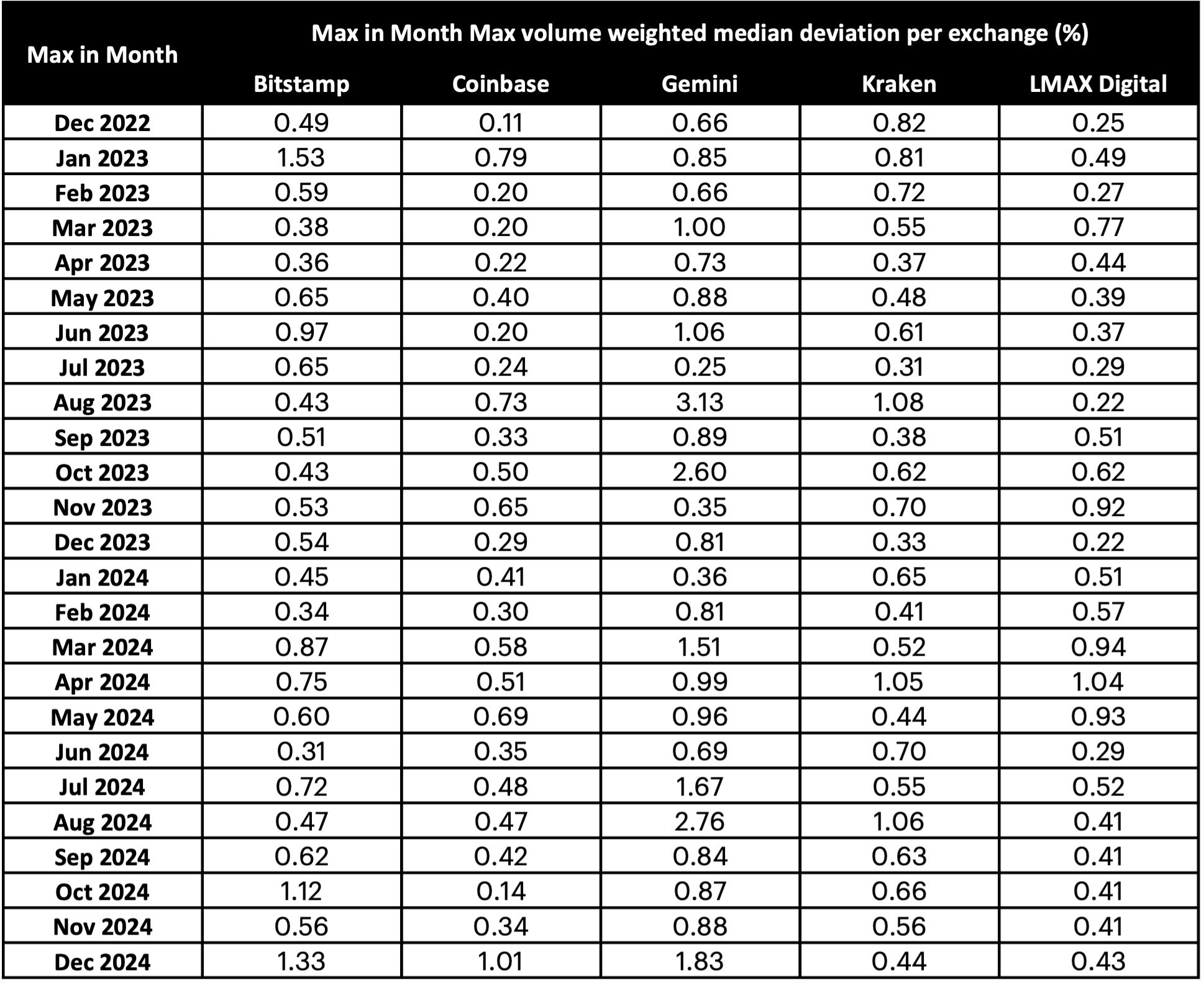
Benchmark Surveillance
Although a series of measures have been undertaken to mitigate the risk of benchmark manipulation, CF Benchmarks remains vigilant against attempted benchmark manipulation and monitors input data continuously. To that end, CF Benchmarks has implemented a benchmark surveillance programme for the investigation of alerts. Instances of suspected benchmark manipulation are escalated through appropriate regulatory channels in accordance with CF Benchmarks’ obligations under the UK Benchmarks Regulation (UK BMR). Regarding benchmark manipulation, Article 14 of the UK BMR, Reporting of Infringements, states:
- An administrator shall establish adequate systems and effective controls to ensure the integrity of input data in order to be able to identify and report to the FCA any conduct that may involve manipulation or attempted manipulation of a benchmark, under Regulation (EU) No 596/2014.
- An administrator shall monitor input data and contributors in order to be able to notify the FCA and provide all relevant information where the administrator suspects that, in relation to a benchmark, any conduct has taken place that may involve manipulation or attempted manipulation of the benchmark, under Regulation (EU) No 596/2014, including collusion to do so.”
As a regulated Benchmark Administrator, CF Benchmarks is subject to supervision by the UK FCA. Furthermore, CF Benchmarks’ Control Procedures with respect to compliance with the UK BMR have been audited by ‘Big Four’ accountancy firm KPMG. The ISAE 3000 Independent Reasonable Assurance Report regarding CF Benchmarks compliance with the UK Benchmarks Regulation as of 12 September 2024 is available at the following link:
https://www.cfbenchmarks.com/legal/audit
This further verification of CF Benchmarks’ compliance with the UK BMR places the CME CF Litecoin-Dollar Reference Rate on the same level of scrutiny applied to widely used traditional financial benchmarks like ICE SWAP, SONIA and RONIA.
Assessing CME CF LTCUSD_RR values and input data for signs of manipulation
Whilst the CME CF LTCUSD_RR was designed and is administered to the highest standards, including efforts to uphold provisions of the UK BMR, the proof of the pudding is in the eating and further analysis of the data is required.
Were there to be a lack of integrity in the input data that could in turn affect the integrity of the benchmark, one would expect to see one of a number of phenomena reflected in the input data provided by Constituent Exchanges. One potential example would be significant price dislocations between Constituent Exchanges.
How well correlated are Constituent Exchange prices?
An analysis was undertaken of the pair-wise correlation of prices from Constituent Exchanges on a per-minute basis (the price difference between transactions for each minute at each exchange) during the observation period. The results of this analysis are shown in Table 2.
Table 2

To illustrate the data analysed in Table 2 in graphical form, Figure 3 (below) displays the full data set. The clustering towards correlation coefficients of 1.00 and the fact that on less than 10.28% of days any exchange had a correlation with another exchange below 0.5 demonstrate strong price correlation between the Constituent Exchanges and point towards fair and orderly markets.
Figure 3
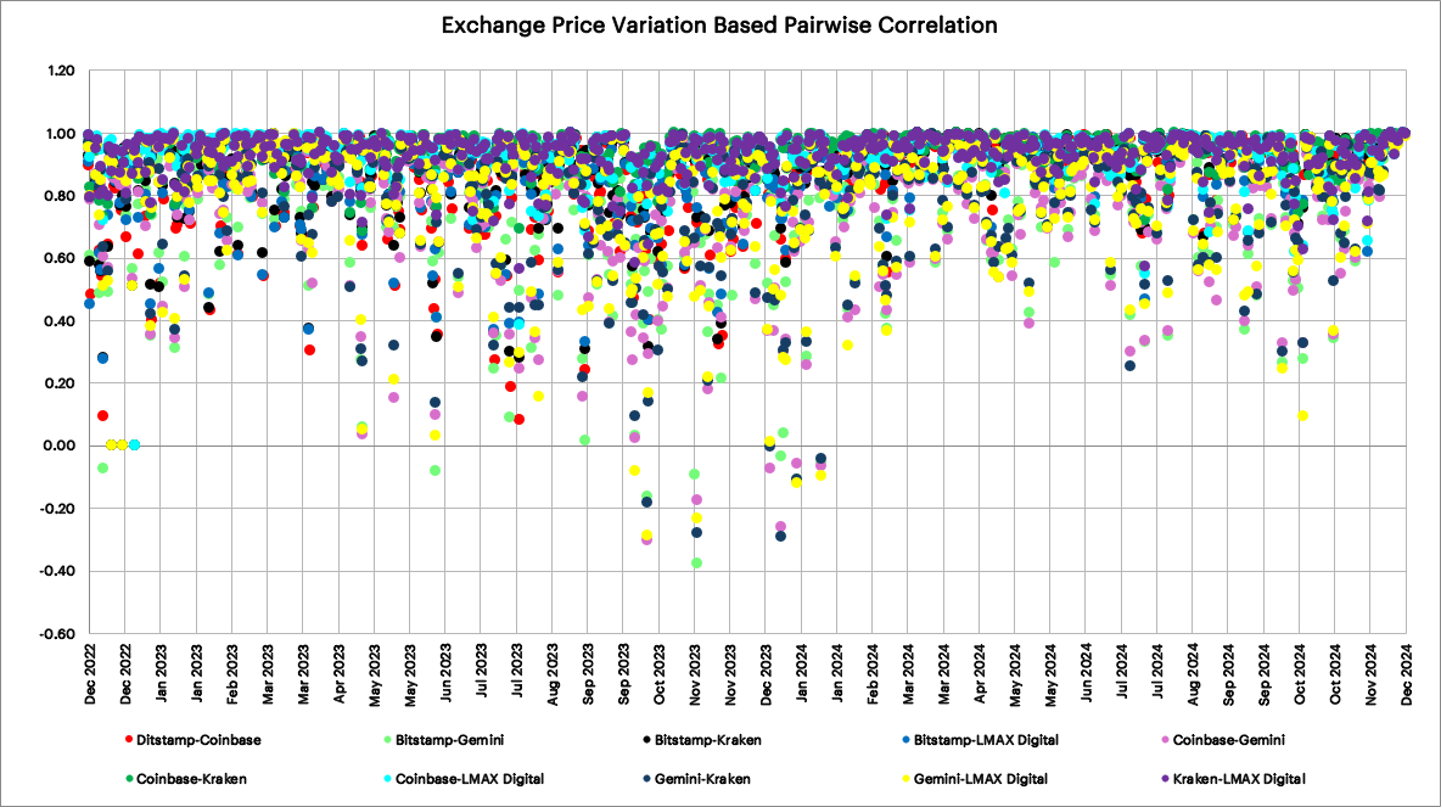
Replicability and Implementation
The final characteristic of the LTCUSD_RR that this paper will examine with respect to its merits as a benchmark price is its replicability. In other words, that the LTCUSD_RR benchmark price can be transacted in practice on any given day without undue risks.
Buying and selling large amounts of Litecoin at LTCUSD_RR
To begin demonstrating the replicability—or to use another term, the achievability—of the strategy presented in this paper for purchasing Litecoin ‘at scale’, observations taken whilst modelling the purchase or sale of a notional large amount of Litecoin are presented below. It was decided that the purchase or sale of 1,979 Litecoin (c. $203.4K at prevailing prices) was at an adequate scale to represent a large Litecoin trade of the kind that institutional traders might need to undertake for a client, or that an issuer of a financial product (such as an ETF or a derivative) would be required to execute on any given day, in order to facilitate trading of that product. A simple replication simulation was thereby conducted to demonstrate the extent of slippage that implementation of the LTCUSD_RR would probably encounter. Given the purpose is to demonstrate institutionally sized liquidity, the simulation was conducted for weekdays only.
Simulation Methodology
- Trades are executed on n (5) Constituent Exchanges, during a 3,600-second window
- One trade is executed every second and the price achieved is assumed to be the last execution price observed in that second. Its associated volume is assumed to be the volume executed during that second
- If no trade is completed in any single-second period, then the price achieved is assumed to be the price achieved in the previous second, but the associated volume from the previous second is not added to the volume executed in the latest second
It is worth noting that in the ‘real world’, institutions deploy algorithmic systems to execute large-scale asset purchases. It is highly probable that conducting the exercise presented here by means of algorithmic systems would have produced outcomes that are even more favourable. For research purposes, a simplified simulation methodology was favoured to demonstrate the replicability properties of the LTCUSD_RR.
The results of this exercise are displayed in Figure 4 and summary data provided in Table 3. As can be seen, the LTCUSD_RR can be replicated with a high degree of confidence and usually with slippage, in most cases, below 10 basis point. Indeed, even on the most volatile of days slippage was only around 86.9 basis points.
Figure 4
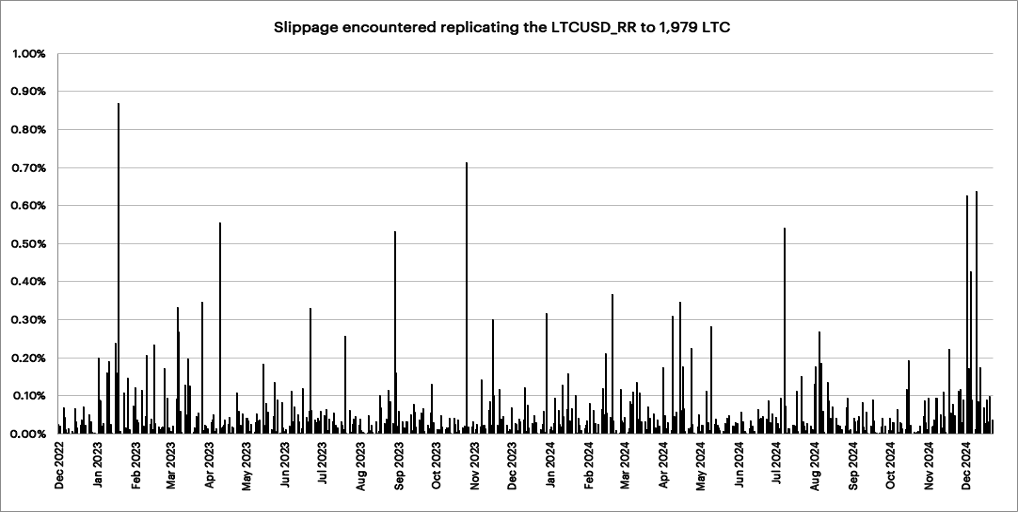
Table 3
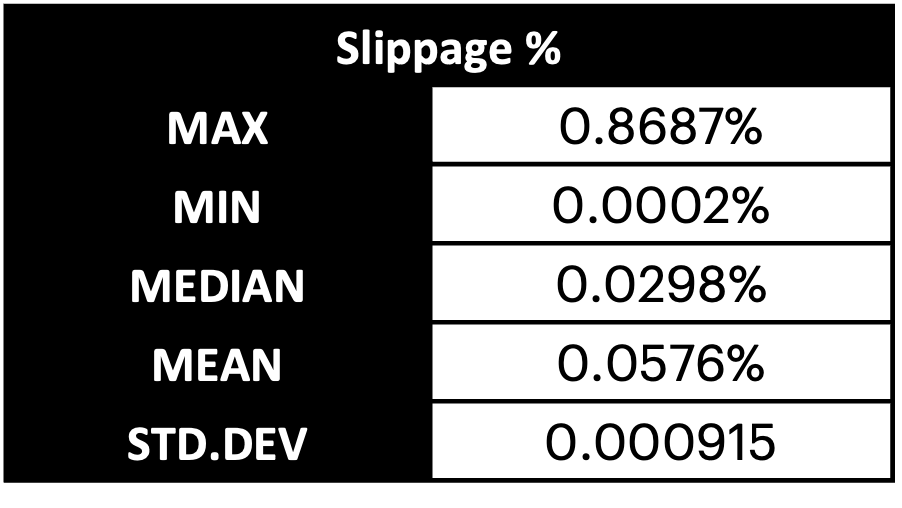
Conclusion
From the analysis conducted it is quite clear that the CME CF Litecoin-Dollar Reference Rate exhibits all the key properties required of a benchmark.
Representative: Litecoin-USD markets that are operated by the CME CF Constituent Exchanges during 1500 to 1600 London time are liquid, with sufficient volume of trading to represent the market in a robust manner.
Resistant to Manipulation: Its Constituent Exchange Criteria ensures that it takes input data only from cryptocurrency exchanges that exhibit fair and orderly behaviour, where trading shows strong price correlations amongst each other. On top of this, the methodology the LTCUSD_RR employs nullifies effects of any manipulation, and the Administrator’s policies and processes regarding surveillance ensure that any manipulation is detected.
Replicable: Its methodology promotes replicability, allowing users to replicate the benchmark simply and without undue risks.
Click here to visit the CME CF Litecoin-Dollar index page
The information contained within is for educational and informational purposes ONLY. It is not intended nor should it be considered an invitation or inducement to buy or sell any of the underlying instruments cited including but not limited to cryptoassets, financial instruments or any instruments that reference any index provided by CF Benchmarks Ltd. This communication is not intended to persuade or incite you to buy or sell security or securities noted within. Any commentary provided is the opinion of the author and should not be considered a personalised recommendation. Please contact your financial adviser or professional before making an investment decision.
Note: Some of the underlying instruments cited within this material may be restricted to certain customer categories in certain jurisdictions.
The information contained within is for educational and informational purposes ONLY. It is not intended nor should it be considered an invitation or inducement to buy or sell any of the underlying instruments cited including but not limited to cryptoassets, financial instruments or any instruments that reference any index provided by CF Benchmarks Ltd. This communication is not intended to persuade or incite you to buy or sell security or securities noted within. Any commentary provided is the opinion of the author and should not be considered a personalised recommendation. Please contact your financial adviser or professional before making an investment decision.

